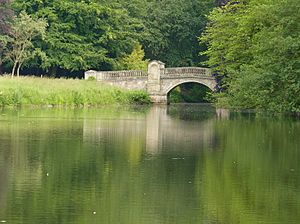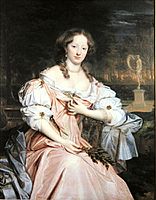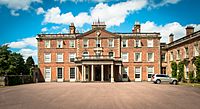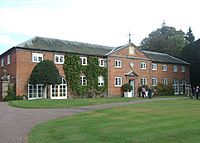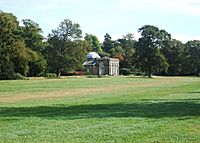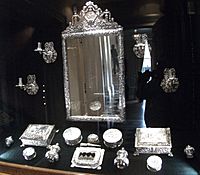Weston Park facts for kids
Quick facts for kids Weston Park |
|
|---|---|
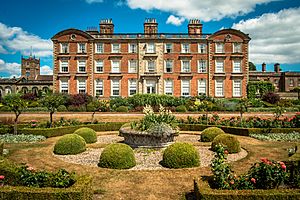
The South (garden) side of the house
|
|
| Type | House |
| Location | Weston-under-Lizard, Staffordshire |
| Built | c. 1670 |
| Architect | attributed to Elizabeth Wilbraham |
| Architectural style(s) | Carolean |
| Governing body | Private |
|
Listed Building – Grade I
|
|
| Official name: Weston Hall and service wings to north and east | |
| Designated | 16 May 1953 |
| Reference no. | 1039264 |
|
Listed Building – Grade II
|
|
| Official name: Orangery and attached link to house, 25 m west of Weston Hall | |
| Designated | 16 May 1953 |
| Reference no. | 1374071 |
|
Listed Building – Grade II
|
|
| Official name: Gateway attached to south west of Stable Block of Weston Hall | |
| Designated | 4 July 1985 |
| Reference no. | 1374073 |
|
Listed Building – Grade II
|
|
| Official name: Stable Block, 60 m to north east of entrance front of Weston Hall | |
| Designated | 16 May 1953 |
| Reference no. | 1188130 |
|
Listed Building – Grade II
|
|
| Official name: Stables and Granary at Weston Hall | |
| Designated | 16 May 1953 |
| Reference no. | 1188133 |
| Lua error in Module:Location_map at line 420: attempt to index field 'wikibase' (a nil value). | |
Weston Park is a large, historic country house in Weston-under-Lizard, Staffordshire, England. It is surrounded by over 1,000 acres of beautiful parkland. This park was designed by the famous landscape artist Capability Brown.
The estate is located about 10 miles from Wolverhampton and 8 miles from Telford. The main house was built in the 17th century and is so important that it is a Grade I listed building. This means it is protected as a special historic site. Other buildings on the property, like the stable block, are also listed for protection.
In 1986, the family who owned Weston Park gave it to the country. Now, a group called the Weston Park Foundation takes care of it. The house is open to visitors and contains a huge art collection with more than 30,000 items.
Contents
History of Weston Park
Early History
The story of Weston Park begins a very long time ago. The land was first mentioned in the Domesday Book, a survey of England made in 1086. In medieval times, the area was a forest and a park where deer were kept for hunting.
The land was first owned by the de Weston family. Later, it passed to the Mytton family and then to the Wilbraham family through marriage. Finally, it came into the hands of the Earls of Bradford.
Who Built the House?
The main house was built in 1671 for a woman named Lady Elizabeth Wilbraham. Many people believe she designed the house herself, which was very unusual for a woman at that time. While there's no final proof, we know she was very involved. Her copy of a famous architecture book by Palladio, filled with her notes, is still in the house's collection.
The house originally had a U-shape with an open courtyard. In the 1800s, the owners made big changes. They moved the main entrance and put a roof over the courtyard to create new rooms inside.
The Bridgeman Family and Capability Brown
In the 1700s, the Bridgeman family inherited Weston Park and made it their main home. They hired the famous landscape architect Capability Brown to design the parkland. He was known for creating natural-looking landscapes with rolling hills, lakes, and carefully placed groups of trees.
The family also hired architect James Paine. He made changes to the house and added special features to the park, like the Roman Bridge and the Temple of Diana.
The Amazing Art Collection
Weston Park is home to a fantastic art collection. It includes many portraits of people from the 1600s to the 1900s.
Some of the highlights include:
- Paintings by famous artists like Anthony van Dyck and John Constable.
- A painting of horses by George Stubbs.
- Beautiful furniture made for the house by the famous designer Thomas Chippendale.
- A room with large, detailed pictures woven from thread, called tapestries. These were made in Paris in the 1760s.
- A very rare silver toilet service (a set of items for a dressing table) from 1679. It is one of only 12 of its kind left in England.
Exploring the Grounds
Besides the main house, there is a lot to see at Weston Park. Next to the house is St. Andrew's Church, which was built around 1700. The stable block, granary, and an orangery (a building like a greenhouse for growing orange trees) are also historic buildings.
The gardens and park are huge and include a lake and even a miniature railway. Some special features in the park are:
- The Roman Bridge: A beautiful stone bridge that crosses a lake called the Temple Pool.
- The Temple of Diana: This building looks like an ancient Roman temple but was actually used as a greenhouse and a garden house. Inside, there are painted panels showing scenes from the life of the Roman goddess Diana.
Famous Visits and Events
Weston Park has hosted many important people and events over the years.
- In 1922, Princess Mary, the daughter of King George V, spent part of her honeymoon here.
- In 1998, world leaders held a meeting at the house for the G8 Summit. Guests included US President Bill Clinton and Russian President Boris Yeltsin.
For many years, from 1999 to 2017, Weston Park was one of the locations for the popular V Festival music event. It also hosts the Midland Game Fair every September, a large event celebrating country life that attracts thousands of visitors. In 2023, it hosted the Camp Bestival Shropshire festival, and in 2024, it was the site of the English National Cross Country Championships.
Gallery
-
Lady Elizabeth Wilbraham, who may have designed Weston Park. This portrait is by Sir Peter Lely.
-
Mary Wilbraham by John Michael Wright
-
Grace Wilbraham by John Michael Wright
See also
 In Spanish: Weston Park para niños
In Spanish: Weston Park para niños
- List of Grade I listed buildings in Staffordshire
- Listed buildings in Blymhill and Weston-under-Lizard


